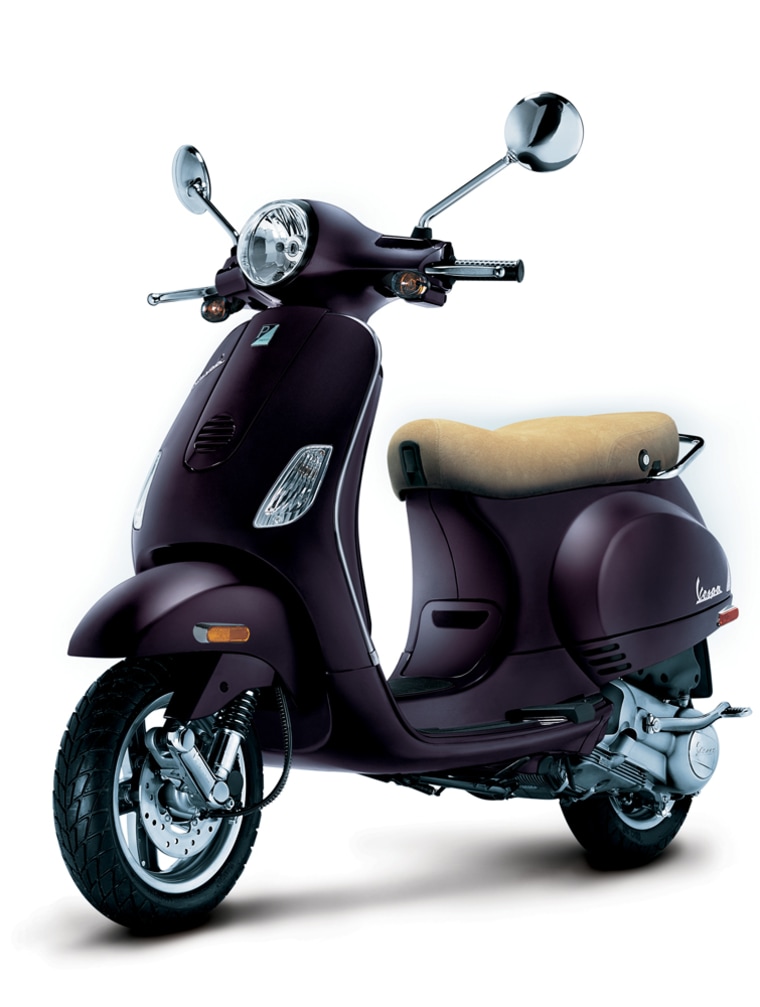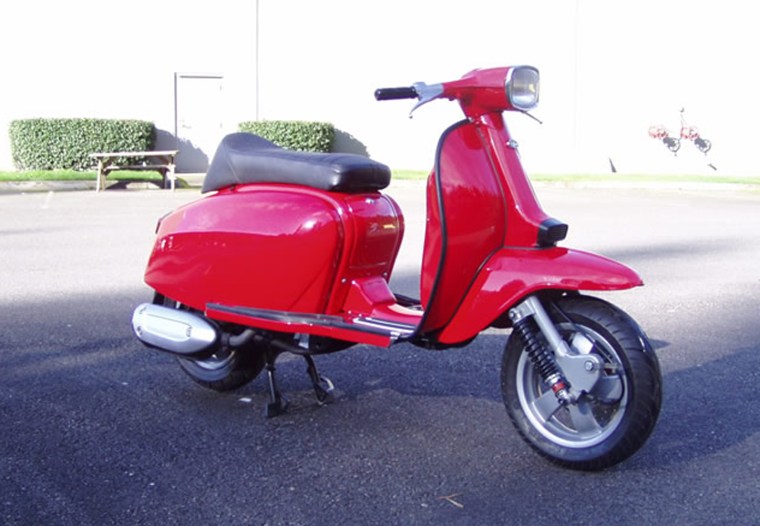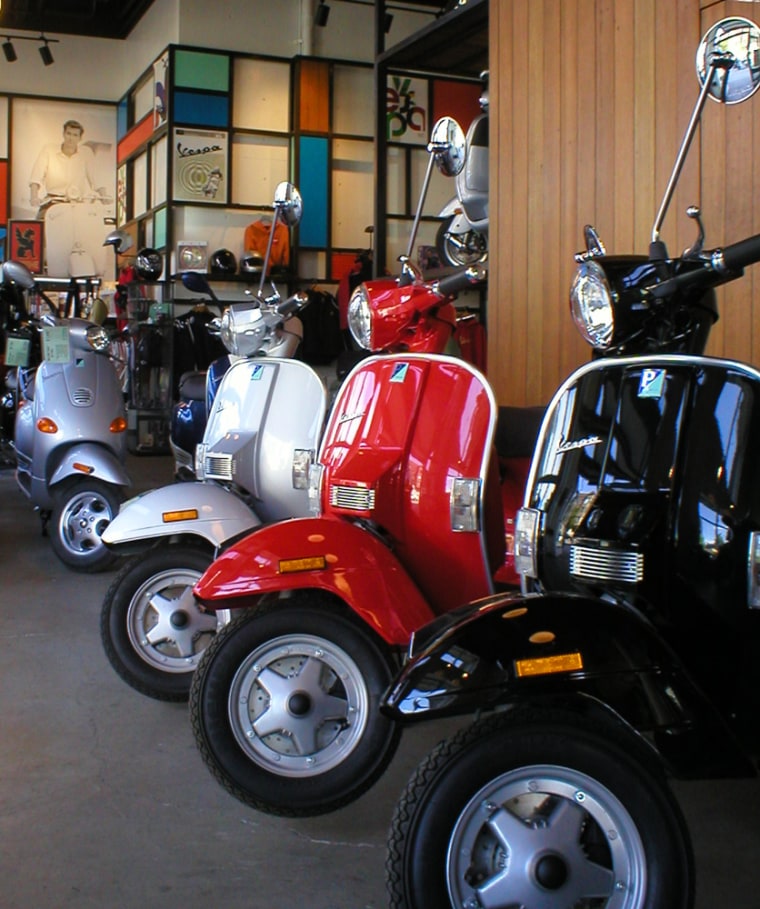At the end of World War II, Italy was trying to dig itself out of economic disaster.
Enrico Piaggio’s father's aircraft factory in Tuscany was in ruins, destroyed by Allied bombers. In Milan, Ferdinando Innocenti faced a similar problem with his steel tubing plant.
Both men turned their focus to the personal transportation needs of fellow Italians. Using the aeronautical resources salvaged from his plant in 1946, Piaggio’s designers came up with a two-wheeled vehicle that was unlike the dirty and intimidating motorcycles of the day. Legend has it that when Piaggio first saw the bike, he exclaimed "sembra una vespa!" (It looks like a wasp!) A short time later, Innocenti introduced a similar machine, named after the nearby Lambro River. Vespa and Lambretta became synonymous with scooters.
To commemorate its 60th anniversary, Vespa introduced the new LX line Tuesday, two months after the European debut. It's the company's second model release in the U.S. this year.
Generations of cool
Italian scooters first grabbed the attention of mainstream America in 1953, when Audrey Hepburn and Gregory Peck rode a Vespa in "Roman Holiday." The bikes were transformed from ubiquitous utility vehicle to fashion statement in the early 1960s, when British "mod" teens shunned motorcycles for the cleaner lines of the Italian machines.
Sears sold Vespas in the U.S. under the “Allstate” brand in the 1950s and 1960s. Montgomery Ward carried the less successful “Riverside” line of bikes that included Lambrettas.
In the early 1970s, the Innocenti factory closed its doors, but production of Lambrettas continued in India for the next decade.
By the early 1980s, small shops scattered throughout the U.S. sold and serviced the bikes. But in 1985, new emissions standards forced Vespa to leave the country.
Over the next decade, European countries began adopting increasingly strict environmental policies, forcing Vespa to reduce emissions and eventually paving the way for a return to the U.S. in 2000. “The U.S. is an attractive market,” said Paolo Timoni, CEO of Piaggio USA. “More than 16 million units have been sold worldwide since 1946,” he said. “The U.S. is largely untapped.” Timoni admitted that the company isn't as familiar with Americans as it is with the European market. Last week, Vespa announced VespaBlogs.com, an attempt to develop a stronger relationship with customers and to integrate with the already existing U.S. scooter community.
In recent years, retailers have seen an increase in sales, and the familiar bikes are often seen in movies (Nicole Kidman rides a vintage one in “The Interpreter”) and in television spots advertising anything from overnight delivery to heartburn medication.

Vespa Seattle owner Victor Voris attributes the growing popularity to a change in American life. “The trend nationwide is a move back to the urban core. Affluence is returning to cities,” he said. “People are looking for ways to get around in that environment.”
Vespa's latest model, the LX (60), replaces the successful ET line, introduced in 1996. "It's mostly a style redesign," said Timoni. "It has a larger front wheel, a new shock absorber and new saddle, but mainly, it brings the look more in line with the GT 200,” released in 2003. Like the ET and GT, the LX has an automatic transmission, much to the disdain of classic scooter enthusiasts. Both the 150cc and 50cc models, retailing for $4,199 and $3,199, sport four-stroke engines.
End of an era
Earlier this year, Vespa quietly launched the two-stroke, manual-shift PX 150, the latest in the “P” series range that has been around since 1978.
Similar to the P200E and P125X available in the U.S. before 1985, it may be the end of the line for the “classic” Vespa. Although its complies with current emissions standards in most of the U.S. (with the exception of California), new regulations here and in Europe mean the model will only be available until the end of next year. “The two-stroke engine can be made to comply with the new standards,” Timoni said, “but Piaggio has no plans for it at this time.” He added the company is doing market research on the demand for manual shift in future models.
Legend returns
In the 1979 mod melodrama “Quadrophenia,” Phil Daniels' Jimmy Cooper may have coveted Sting’s Vespa, but he and his pals all rode Lambrettas. The sleeker, more angular styling and removable body panels drew many loyal fans throughout the years. Since the Innocenti company’s demise, a cult following has developed around the bikes. Specialty shops and organizations were established to help owners keep their vintage Lambrettas running.
In March, a prototype for the first new Lambretta in decades was unveiled at the Indianapolis Motorcycle Dealer Expo. Reintroducing the bike was a personal mission of Lambretta USA President Harry Khurana. “I purchased my first Lambretta scooter back in India in the 1960s and feel it’s a great honor to bring it back after all these years of absence,” he said.

The new Lambretta will be produced by CMSI, which also makes TN’G scooters and Blackhawk ATVs. CMSI President Tom Lynott says the new bikes will be manufactured in North Carolina. Outwardly, they will maintain the classic Lambretta look, based on the GP and SX models of the late 1960s. Inside, however, it will feature a modern Piaggio engine. Lynott hopes the engine won’t be a turn off for the Lambretta audience. “We really hope we can appeal to the enthusiast and the diehard Lambretta followers,” he said. Lynott compared the new Lambretta to Harley Davidson. “For years, Harleys were unreliable, yet owners stuck with them,” Lynott said. “Now they can have a bike to show and a bike to ride. The same will be possible for vintage Lambretta owners.”
Lambretta USA plans to be on showroom floors, with 125cc and 250cc models, by October. Lynott said pricing will be in line with Vespa’s models.
Scootering into the future
In other parts of the world, the scooters are undergoing a transformation. “We’re starting to see a sales decline in 50cc engines in Europe. Larger models are coming into play,” said Timoni. Piaggio currently makes two 500cc models, the X9 and the BV500. Recent acquisition Aprilia sells the Atlantic 500 and Scarabeo 500, both powered by Piaggio engines. Additionally, Honda has the 582cc Silverwing, Suzuki has the Burgman 650 and Yamaha has the Majesty 400 and TMax 500. A 250cc version of the Vespa GT has been rumored to be announced soon.
Voris said the market for these so-called maxi scooters is a bit different than the traditional scooters. “They tend to be older motorcycle riders, the ones who have been riding the big Goldwings,” he said. “They’re finding that they don’t need 1100ccs of power to get around town. Plus, some of them begin to have problems getting their leg over the seat, so a step-through frame is very attractive.”
Khurana noted that the scooter market will continue to grow. “With the low operating costs of a scooter, increasing fuel prices and lack of parking at work and school, more people are realizing the benefits of a scooter for reliable daily transportation, he said.
